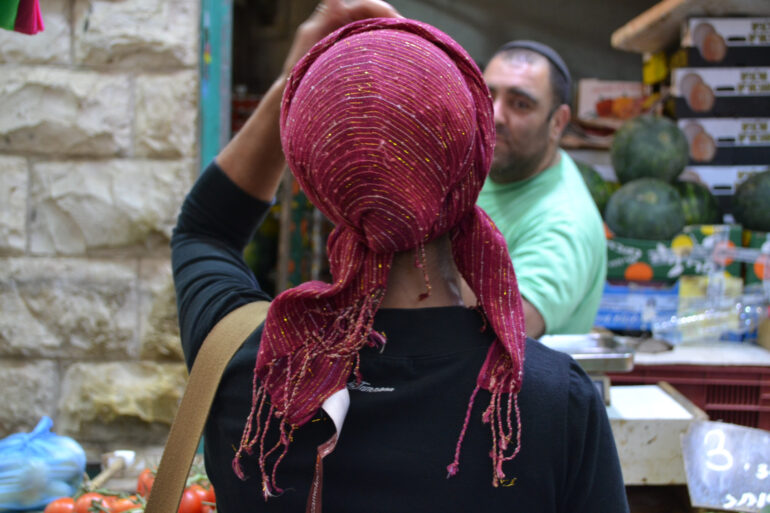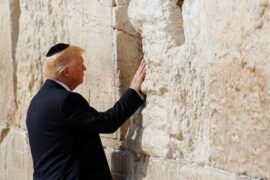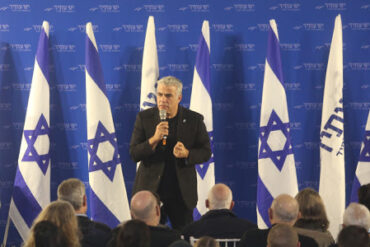Jewish women today have sacrificed many of their authentic values without even being aware of it. My experience teaching young Jewish women has taught me that the values these students believe define strong female Biblical heroines are radically different from the values they have been conditioned to believe define strong women today. In what appears to be an astounding display of cognitive dissonance, Jewish women apply the underlying values of classical Western feminism to their roles in Jewish life at the expense of authentic Hebrew values.
Most Americans, whether or not they are aware of the three waves of feminism in the United States, are familiar with the rights and ideas each of these waves has struggled to advance. The first wave took place in the late 19th and early 20th centuries and consisted mainly of fighting for basic rights, like those of property ownership and suffrage. The second wave came alongside the sexual revolution in the 1960s and consisted of a struggle for rights pertaining to the family and the body, such as the rights to birth control and abortion, the criminalization of marital rape, and combatting sex discrimination on the basis of pregnancy. And the third wave, which began in the early 1990s, focused on questioning, reclaiming, and redefining ideas that have transmitted basic assumptions relating to gender, gender roles, beauty, and sexuality.
Many are less familiar, however, with the almost half century old feminist critique of American feminism, Critical Race Feminism. Critical Race Feminism, an offshoot of Critical Race Theory, focuses on the experiences of women of color and serves as a critique of each wave of the feminist movement on one central point: the complete lack of regard for the unique experiences of women who are not white.
What does this mean exactly? Mari Matsuda, an Asian American feminism theorist, coined the term “multiple consciousness”[1] to describe the phenomenon experienced by women of color who struggle to balance multiple identities, switching when relevant between female consciousness and ethnic/racial consciousness in order to protect the full amalgam of who they are. This multiple consciousness generally plays out in spheres of both discrimination and identity.
Professor Kimberlé Williams Crenshaw, a black American lawyer and scholar of Critical Race Theory, assisted Anita Hill’s legal team in 1991 in the sexual harassment case against then U.S. Supreme Court nominee Clarence Thomas. Following the trial, she wrote an article[2] that examined the hearings within the broader scope of how black women feel they must identify themselves and their experiences to the world. When confronted by sexism, she noted that they feel obligated to explain their experience in a manner familiar to white women. And when challenged by racism, they feel the same obligations to express themselves within the black male’s frame of reference. But according to Dr. Crenshaw, black women who experience sexual harassment are often harassed on both accounts – not because they are black and not because they are women, but because they are black women – so their true story is never fully expressed.
Margaret Montoya, an American lawyer of Mexican descent, wrote an autobiography[3] that relays her childhood experience as a Latina going to a school in a white neighborhood. Every morning before school her mother would pull her hair into tight braids so that she wouldn’t look too Mexican. She coins the term “unmasking” to describe the decolonization of her Mexican identity and intertwines it with her experience as a Latina, trying to find her place as a Mexican woman in white male-dominated America. She writes, “For Outsiders, unmasking is a holistic experience: I do not have separate masks for my female-ness and Latina-ness.”
Regardless of whether or not a Jewish woman living in the U.S. consciously identifies as a woman of color, I assume she can relate to the Critical Race Feminist concept of “multiple consciousness.” For those Jewish women reading this, ask yourselves how often you switch back and forth between being a woman and being a Jew. When you attend an Israel Day parade, you’re a Jew, united with all other Jews, male and female. When you experience an act of severe anti-Semitism, you may leave out the details of the fear and helplessness you might have felt as a womanexperiencing that act. And if you are the only woman on your school’s sports team, you are a woman, united with all other women, be they Hebrew or Gentile. The fact that you might have also been making a statement that you, as a strong Jew, are a competitive opponent to non-Jewish students across your city may not fit prominently into the story you tell your peers.
And if that is the case, then what does it actually mean to be a Jewish woman, in its fullest and most complete sense? In what ways are we unique both from other women and from Jewish men? Montoya wrote in her autobiography, “Outsiders are… faced with the gnawing suspicion that the public identities available to them are limited to those reflecting the values, norms, and behavior of the dominant ideology. Lost to all are the variety of choices, the multiplicity of identities that would be available if we were not trapped by the dynamics of subordination.”
In short, we have become so entrenched in Western concepts and definitions of race, ethnicity, and gender, that we have forgotten how to define ourselves according to our own culture.
Fortunately for Jews, unlike many other peoples who have been dominated by the West, our over 4,000-year-old culture remains largely intact (if not a little worse for wear), giving us the unique opportunity to reach beyond the bounds of the values and behavioral norms of Western civilization, and to express ourselves in such a way that forms a holistic identity much greater than the sum of its gendered and ethnic parts.
Before my wedding I knew that my ring would be placed on my right forefinger under the ḥuppah, because every Jewish bride receives the wedding ring on this finger. But I never knew why. And I also did not know why all the married Jewish women I knew then moved the ring to their left “ring” finger. So prior to choosing my ring size I – as a good doctoral student should – researched the topic thoroughly and found that Christians put the ring on the left “ring” finger because of a residual Roman pagan belief that this finger leads directly to the heart, whereas Jewish mystics and sages provide several explanations[4] for the historically consistent practice of Jewish men placing the ring on their brides’ right forefinger (these reasons are relevant not only for the ḥuppah but also for the yadwith which a Hebrew man reads from the Torah).
But as women, in non-Jewish societies where marriage status is acknowledged by whether or not a woman has a ring on her left “ring” finger, we as Jewish women, downplay Jewish and emphasize woman and move our rings to the “ring” finger as defined by other, non-Israelite, women. So I had my husband buy me a ring that would fit my right forefinger, because I preferred to express outwardly my complete female Hebrew identity rather than compromise a piece of it in order to fit into monolithic definitions foreign to my people.
We can find a tikkun, a spiritual rectification, of this phenomenon in a number of practices unique to Jewish women, and even in something as seemingly simple as baking ḥallah. Women in every society have been baking bread – the staple and most basic food for communities and families – for thousands of years. And likewise, the Jewish people have been performing mitzvot and making brakhot, for just as long. But baking ḥallah, and reciting the brakha on it is something reserved for Jewish women, that we alone are responsible to provide. The synthesis of an ancient female practice symbolizing sustenance and foundation, with an authentic Hebrew expression of praise to HaShem is the perfect rectification for our own often confused and disjoined identities. It parallels the unification of all of the most beautiful aspects of both our Jewishness and our womanhood. This unification is likewise expressed through several other practices found in our ancient national culture.
These practices parallel the conviction that we as Jewish women have something to offer the world that is completely unique from what Jewish men and Gentile women have to give. For one, we can empathize with oppressed peoples of all kinds. For those of us who have ever felt physically threatened by a male at a Jewish event, we can sympathize with a black woman who experienced sexual harassment and could not convey her full story for fear that either black men or white women would not relate or understand. For any of us who have ever gotten a nose job or straightened our curly Semitic hair in order to conform to white standards of female beauty, we nod our heads in understanding when a Mexican American woman tells a childhood story about her mother tying up her wild hair in braids each morning in an attempt to embody those same white American standards of beauty and propriety.
But what truly sets us apart is that with the unique combination of female intuitiveness and Jewish values (and by Jewish values I mean those authentic values we arrive at after having freed ourselves from those “dynamics of subordination”), we have the tools to be more sensitive to the needs of others, to push the people in our lives to reach their full potential, and to imbue those around us with a sense of purpose and spiritual fulfillment. These have always been the distinct powers of Hebrew women – from the time we coaxed our enslaved husbands in Egypt to continue conceiving children to the time we refused to participate in the sin of the Golden Calf; from when we pushed our men to become fighters for freedom against Seleucid-Greek rule to the time we took Hebron’s abandoned Hadassah clinic in order to expand the city’s Jewish community.
These powers derive directly from the values Hebrew women have strived to embody since the formation of our people. No one denies that our people’s foremothers – Sarah, Rivka, Rahel, and Leah – were all incredibly strong women. But their strength derived not from today’s Western definitions of what makes a woman strong (i.e. being like a man), but rather from the Hebrew definition of what makes a Jewish woman strong: modesty of behavior, foundation of the home, inspirer to action, sustainer and conveyer of the nation’s deepest convictions and values. And while we all agree that our matriarchs were strong, we rarely examine the nature of the values that cause us to see them as such.
Identities can be complex and a Jewish woman’s identity is unusually so. We can only reach our full potential when we understand the gift we have to offer the world that no one else can provide. True Hebrew feminism provides the space for us to live our lives as complete Jewish women, never compromising or downplaying any aspects of our identities in order to be better understood or accepted by someone else. It seeks to perfect Hebrew society and tend to the needs of Jewish women in ways that heighten, rather than dismiss, the values embodied by the heroines of ourpast and not by those of a foreign culture. And finally, it allows us to “unmask” ourselves holistically, to discover and express who we really are to world. The decolonization of our Jewish identities will not be complete unless it is also a decolonization of our Jewess identities. And our feminist victories will not suffice unless they are rooted within our authentic Hebrew values rather than those of the dominant alien cultures around us.
So examine each sphere of your life – at home and at work, in your relationships and on your spiritual journey – and find ways to express not your Jewishness or your femaleness, but rather the holistic manifestation of what it means to be a Hebrew woman. This critical thinking should smash the cognitive dissonance many of us experience, and create the emotional and intellectual space to recognize and appreciate the beauty of our own civilization, as well as our unique roles within that civilization, rather than measure our way of life against foreign and irrelevant yardsticks. The secret to expressing ourselves as strong Hebrew women is defining how we can tangibly manifest the values of our Biblical heroines within the context of our 21st century realities and this unique chapter of Jewish history. Such an approach would certainly lead us to a powerful Hebrew feminism that empowers us to fully and authentically express ourselves as strong Israelite women.
(Originally published at http://www.timesofisrael.com/)
[1] Mari Matsuda, “When the First Quail Calls: Multiple Consciousness in Jurisprudential Method,” (Women’s Rts. L. Rep. 14, 1992) 195.
[2] Kimberlé Williams Crenshaw, “Black Women Still in Defense of Ourselves,” The Nation, Oct. 24, 2011.
[3] Margaret Montoya, “Máscaras, Trenzas, y Greñas: Un/Masking the Self While Un/Braiding Latina Stories and Legal Discourse,” (Harvard Journal of Law and Gender 17, 1994) 185.
[4] “The first mention of placing the ring on the right forefinger as a wide-spread custom dates back at least about a thousand years as mentioned by Rabbi Elazar of Worms (1165-1238) [Roqe’ah 351]. Teshuvot Maharam Mintz [No. 109] explains that in those days women would wear their rings on the right forefinger and therefore this custom has remained. Another reason is suggested in Naḥalat Shiva [12:2] based on the idea that the right forefinger is the most prominent of all the fingers…The Zohar explains [Tikunei Zohar 5, 10, 21 (p. 55b)] that the reason the ring is placed on the right hand is because the right hand represents giving and loving-kindness. Mahariḥ [Likkutim 3:133a] offers a beautiful idea as to why the forefinger. The ḥatan gives the ring with his right hand, which is opposite the left hand of the kallah. The giving is accompanied by seven blessings. The seventh finger from the kallah’s left hand is her right forefinger. Therefore it is symbolic that the “seventh” finger should be the one that ring is placed on, as the giving of the ring is the moment that the kiddushin is sealed.” http://ohr.edu/2244





